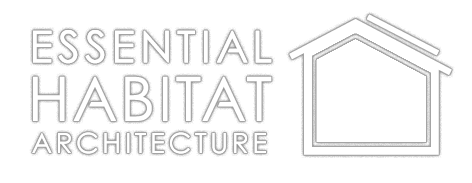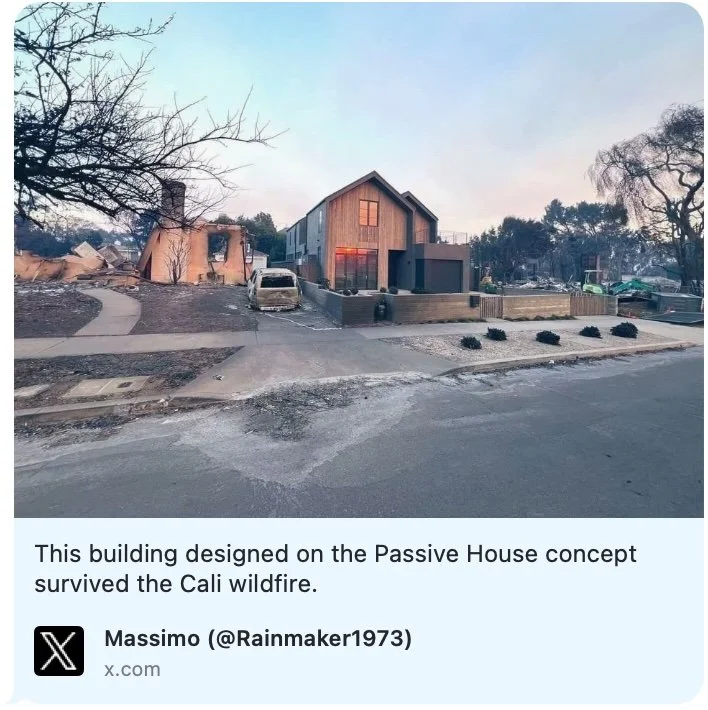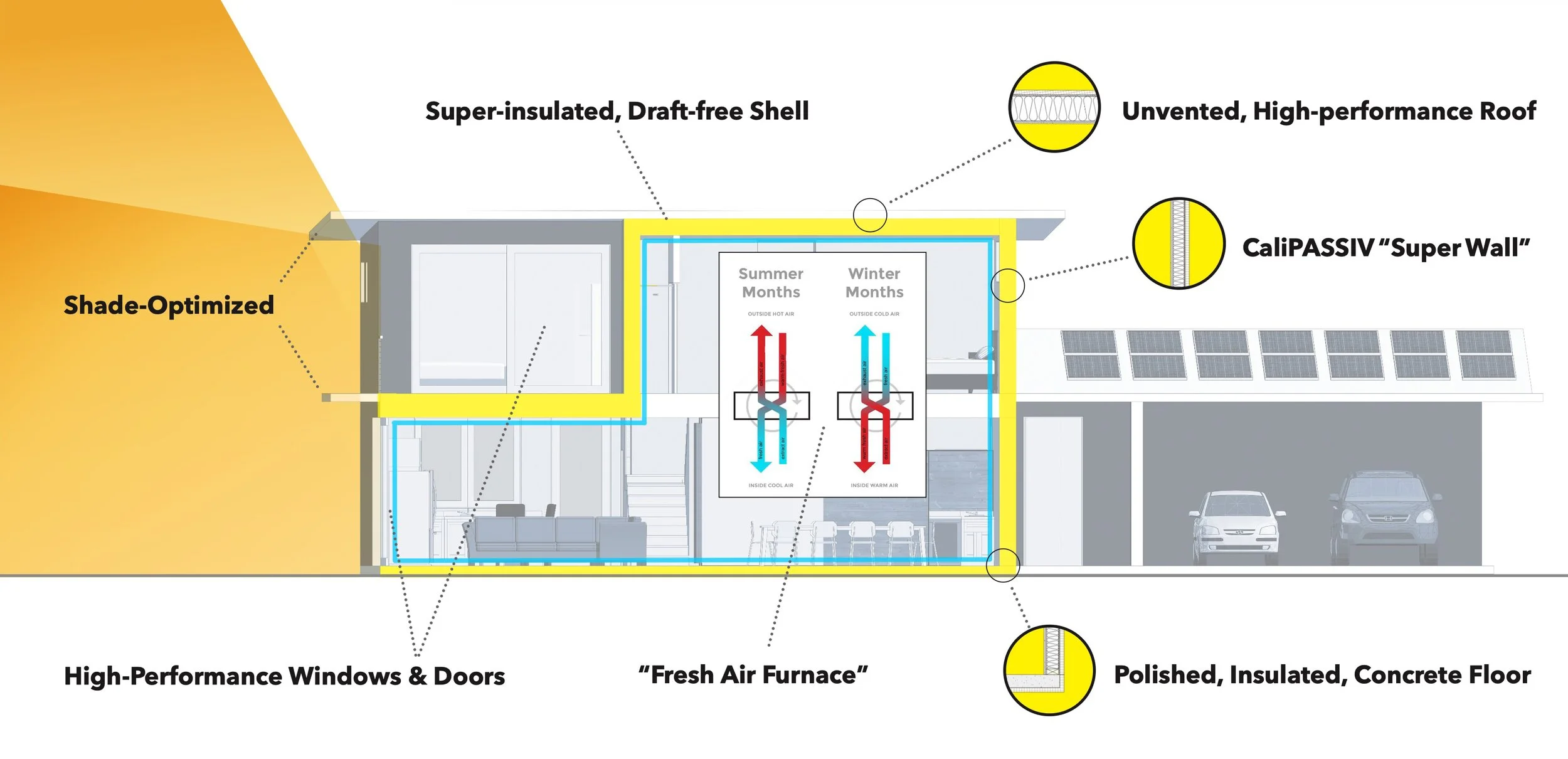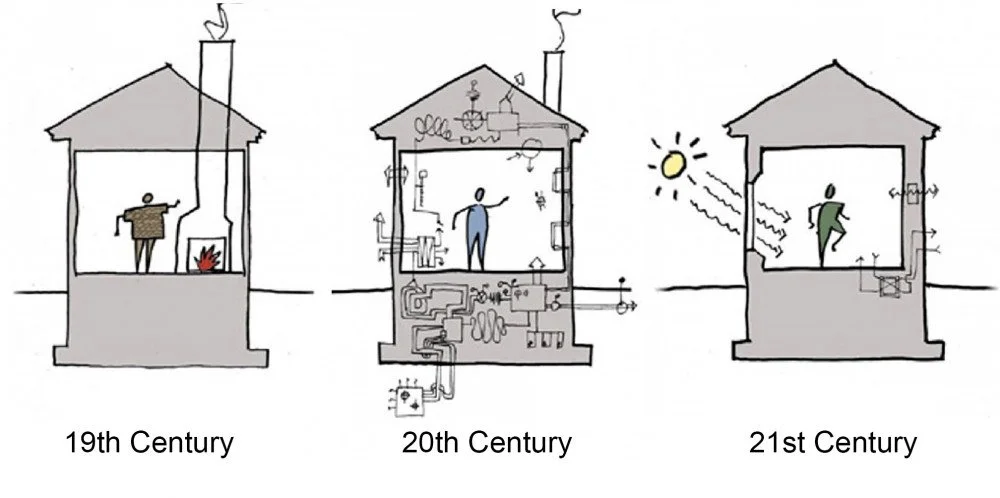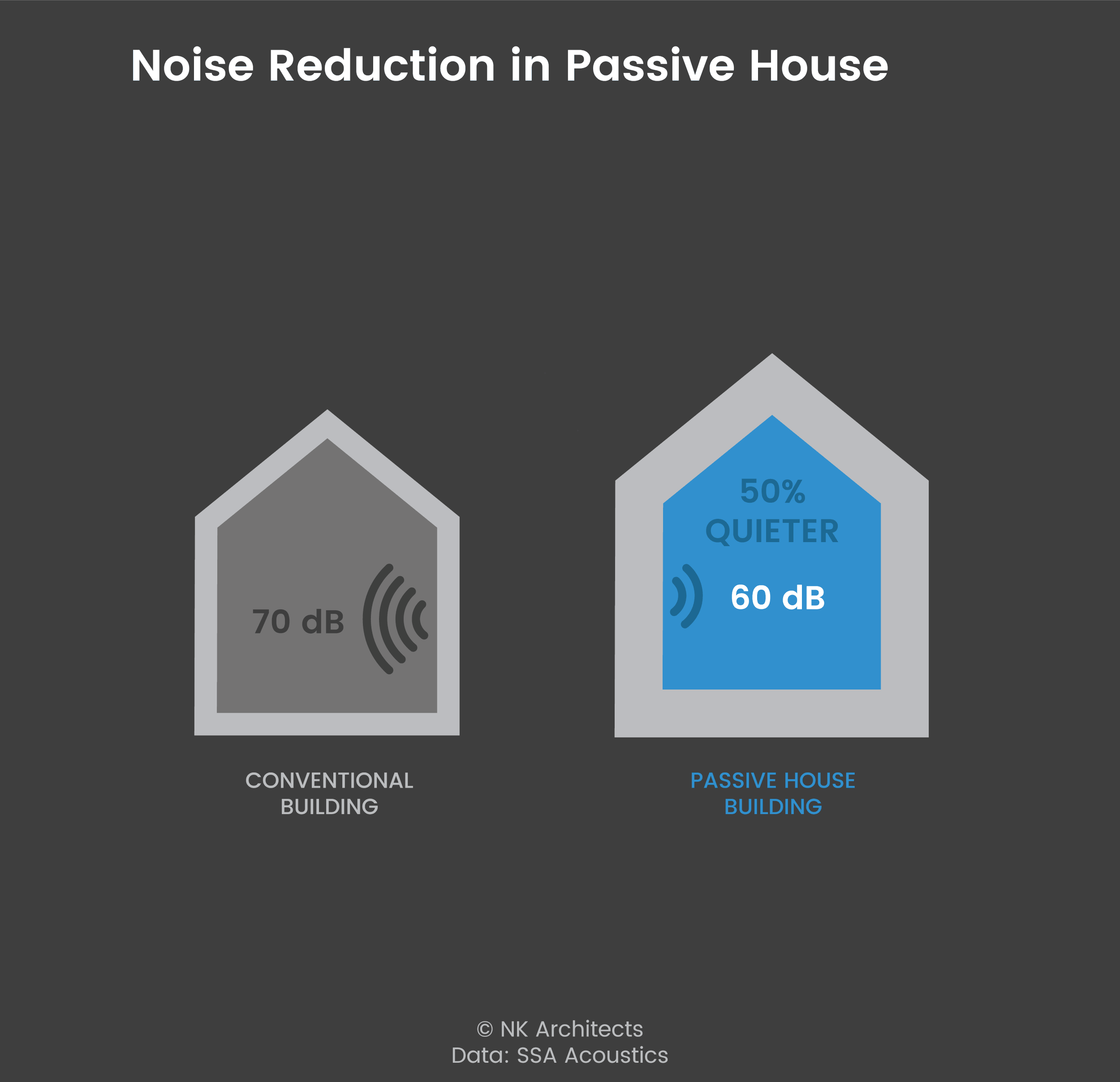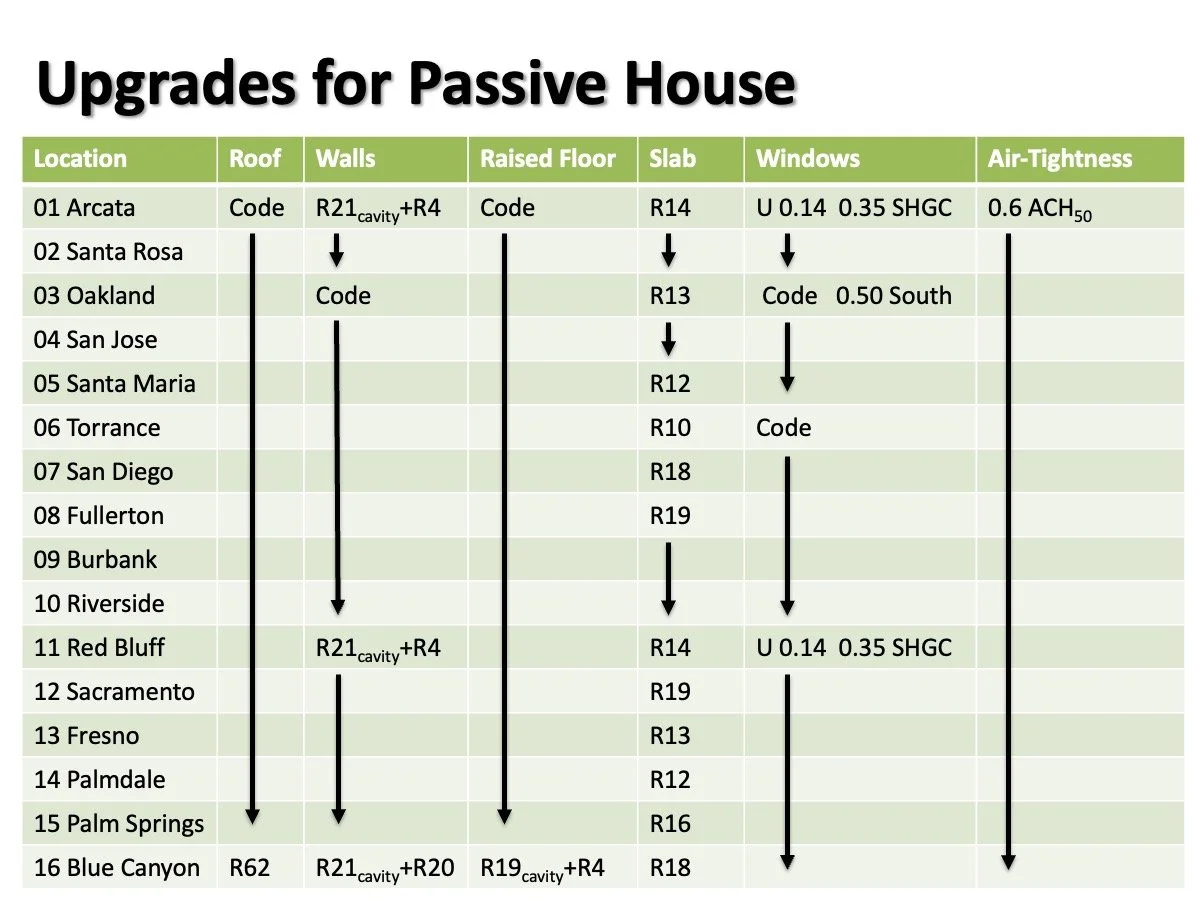Passive House in L.A., Why Bother? Here’s Four Reasons.
Introduction
Amidst coverage last week of the devastating Los Angeles fires came a social media post that went viral, of a “Passive House-inspired” home in Pacific Palisades that survived while its neighbors were destroyed.
Speculation ensued about which aspects of Passive House were responsible for the home’s survival. The architect was interviewed, and when asked about Passive House, concluded “We live in a benign climate here in Southern California… A lot of the measures used in Passive House become overkill.” As a long-time Passive House practitioner in California, I feel obliged to clear up some misconceptions, and share four big benefits our clients gain, even in mild climates.
While the “Nordic modern minimalism” of this home is seen in many Passive House projects, Passive House is not an architectural style. It is, rather, an approach to design and construction focused on creating high-performance buildings. Through precise energy modeling and meticulous design and construction, a Passive House/Building (it’s not just for houses) is created that is largely in balance with its environment. Inherently comfortable, it requires little in the way of “active” heating and cooling, hence the “Passive” moniker.
©2025 Essential Habitat Architecture
A “certified” project is confirmed by a third party to have been designed and constructed to meet exacting Passive House/Building “standards” regarding comfort, air quality, and energy efficiency. While the standards vary a little, the requirements are similar for all projects, so what’s required to achieve this level of performance depends on the design and location. In other words, a Passive House/Building in Minnesota requires much more insulation than one in Southern California, but they’re both equally comfortable and efficient. Calling Passive House “overkill” for Los Angeles misses the fact that this it’s based around climate and project-specific optimization.
Furthermore, it implies that the benefits offered are undesirable and/or unworthy of the effort required to achieve them. As an architect with more than fifteen years’ experience designing high-performance Passive Houses and Buildings in California, I wholeheartedly disagree. What follows are four noteworthy benefits delivered to owners and occupants, even in Los Angeles:
Benefit #1: Health
©2025 Essential Habitat Architecture
Typical buildings are very leaky. Cracks and holes in the exterior make it difficult to control the volume of air moving in and out of the building, and nearly impossible to control where this air originates. This leaves the occupants of a typical building subject to outdoor air pollution, dust, pollen, insects, and vermin. Much of the air they breathe comes from the worst possible locations – a study in Washington state found that roughly 40% of the indoor air in the test houses came from crawl spaces.
High-performance buildings, by contrast, are meticulously constructed to eliminate leaks. Indoor air quality is ensured via carefully calibrated ventilation systems that continually remove stale air from bathrooms, kitchens, and laundries. This air is replaced with fresh, filtered air from optimal outdoor locations, silently delivered throughout the living spaces. Studies and anecdotal evidence show benefits including better sleeping, reduction of allergy and asthma symptoms, and improved energy and productivity, among others. In the event of wildfire smoke events, supplemental filtration can be added, which has been shown to markedly improve indoor air quality. These buildings are not hermetically sealed - when outdoor connection is desired, doors and windows are easily opened, and natural ventilation for cooling is a strategy that’s commonly employed. We leverage large, high-quality windows and doors for dramatic effect in our projects, emphasizing indoor-outdoor connection.
Benefit #2: Comfort
The basis for great building performance is comfort. Decades of experience and research have been applied to create buildings that are in balance with their surroundings, needing little in the way of supplemental “active” heating and cooling for consistent comfort. The temperature of all the indoor surfaces (ceilings, walls, windows, and floors) is optimized, and the glazing is carefully shaded. Our clients are consistently thrilled with the comfort of their homes. Their biggest issue seems to be, when traveling, how uncomfortable other houses seem in comparison.
Image Source: Albert, Righter and Tittmann Architects
While Los Angeles has a mild climate and sleeping outdoors in winter is likely survivable, it is often far from comfortable. Many homes in the area are poorly suited for year-round comfort, requiring far more energy and equipment than necessary. With tens of thousands of Passive Houses/Buildings across North America, throughout Europe, and around the world providing vastly superior comfort without a typical furnace, it’s worth asking why there should be any building in Los Angeles that needs one.
Benefit #3: Quiet
I’ve been designing high-performance homes and buildings since 2008, yet every time I visit one, I’m still amazed at how quiet and peaceful they are inside. They are truly “sanctuaries in the modern world.”
Image Source: NK Architects
NK Architects, now NK Passive, quantified this effect by commissioning acoustic engineers to study it. They found that outside noise transmission was reduced by at least 50% from a conventional building. We have clients who enjoy the serenity of country living in the middle of San Francisco. For others, who live on a busy street in suburbia, traffic noise is a distant memory.
Benefit #4: Efficiency
In addition to a robust exterior envelope, high-performance buildings use best-in-class lighting, appliances, and equipment. The result is overall energy savings on the order of 75% when compared to typical construction. This radical level of efficiency imparts several advantages - utility costs are lowered for a lifetime, they’re easily powered with solar and can function far longer on batteries during grid outages, and the environmental impact is greatly reduced.
©2025 Essential Habitat Architecture
Clients with a 3 bedroom, 2-1/2 bath, high-performance, all-electric home had electric bills that averaged $20 a month for January through March of 2023, $11 per month of which was the connection fee. Solar output in April yielded a bill of -$67, which paid those months off. They have a typically sized 8 kW solar system and two Tesla Powerwalls which enable them to live their lives, completely uninterrupted, during power outages. This includes charging two EVs.
How Well Does It Work?
We studied the difference between Passive House and California code by taking a state-approved, single-family home prototype and upgrading it to Passive House performance in each of the state’s 16 climate zones. We found variation with climate, as expected, but even in Los Angeles’ three climate zones: CZ6 (coastal), CZ8 (inland south), and CZ9 (inland north), the energy required to heat and cool a single code house was sufficient for three or four of the upgraded houses, respectively. For the sake of clarity in the study, we restricted ourselves from any architectural improvements - this would have yielded even better results.
©2025 Essential Habitat Architecture
What Does It Take?
We’ve developed powerful optimization software, and we used it to carefully chose the most effective upgrades to the code-built house in each climate. We found that the only upgrades required for Passive House performance in Los Angeles were improved air-tightness and insulation for slab-on-grade foundations.
©2025 Essential Habitat Architecture
What Does It Cost?
The additional up-front investment required to achieve the benefits of high-performance varies with the specifics of the project, but we find that 10-15% is typical for single-family projects in California, with higher end projects seeing lower incremental costs.
What About Fire Resistance?
While many of the measures employed in the Pacific Palisades home are consistent with Passive House, they’re more specifically associated with “wildfire-hardening,” which is now required by code in high-risk, “Wildland Urban Interface” (WUI) zones throughout California. This guide, which may also help lower insurance premiums, offers more insight.
Image Source: IBHS
With an eye also cast toward high-performance, however, some aspects of wildfire-hardening can be achieved with techniques that provide multiple benefits. For example, the architect stated that the exterior walls of the Pacific Palisades house have a “one-hour fire rating.” This was probably achieved by wrapping the exterior in fire-rated gypsum board, or the equivalent. We fire-harden our projects as standard practice but, instead of gypsum board, we utilize exterior “stone wool” insulation for a one-hour fire rating that also provides significant comfort and efficiency improvements.
Conclusions
Our experience has found tangible benefits from high-performance buildings, even in mild climates like coastal California. Through concerted effort, we’ve developed ways to achieve this with a minimum of exotic materials and techniques, relying mainly on conscientious design and careful construction. In addition to improving the lives of owners and occupants, high-performance buildings are crucial to mitigating climate change, which is likely responsible, in part, for these disastrous fires. If we’re to escape the environmental damage of fossil fuels, we’ll need to shift to all-electric buildings that are optimized for renewable energy. We call what we do “Architecture for the Future of California.” It’s a double-entendre that speaks of buildings that meet the challenges we face moving forward, and which promise a bright, healthy future for the people our clients love and the places we all cherish.
If you’d like to help encourage high-performance building in California, you can sign this petition to make Passive House an official option for compliance with the state energy code.

